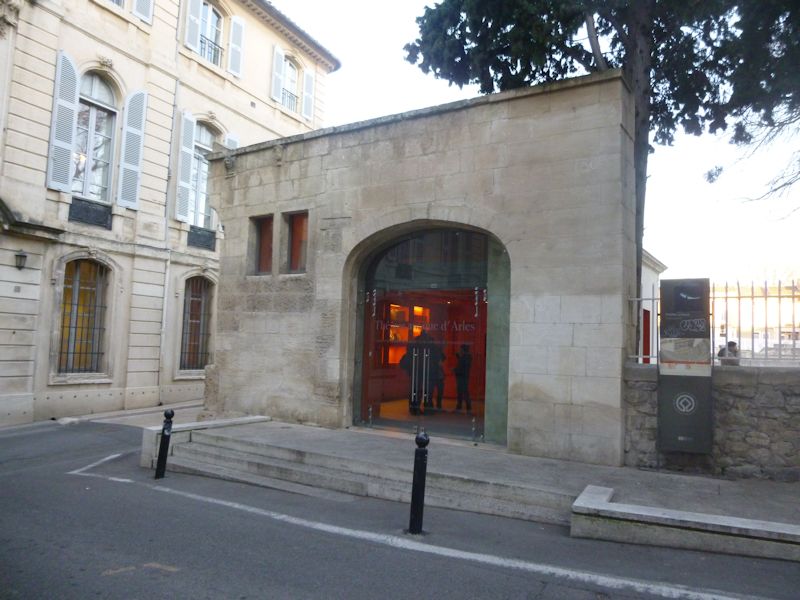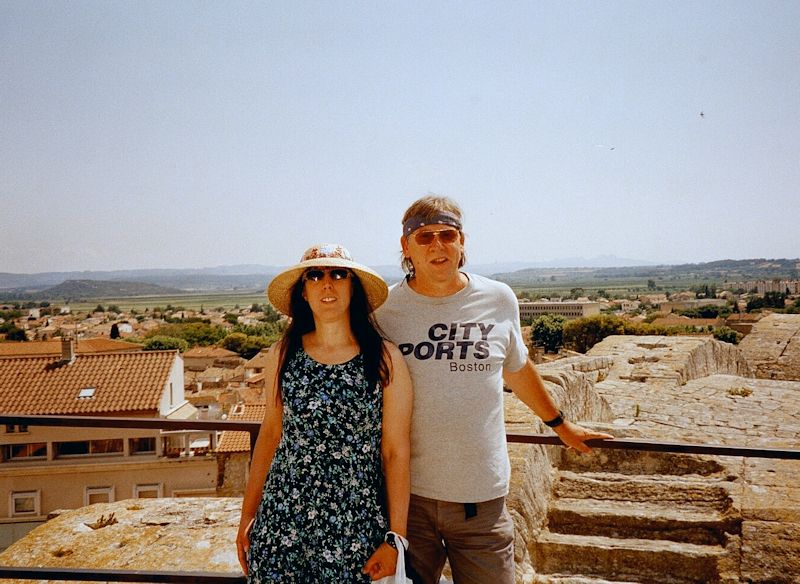|
 Dwight Peck's personal website Dwight Peck's personal website
Ten wintry days in the South of France
Montpellier, Arles, the Camargue, and lots of et cetera
You may not find this terribly rewarding unless you're included here, so this is a good time for casual and random browsers to turn back before they get too caught up in the sweep and majesty of the proceedings and can't let go.
The amphitheatre in Arles

We've just been visiting Saintes-Maries-de-la-Mer on the coast of the Camargue delta of the river Rhône, and decided to piggyback a visit to Arles onto that, why not? This is the main road northeast out of the salt marshes to Arles at the separation of the two branches of the river.

It's late in the day and really, really cold, so this is a Flying Visit, dedicated to the Number One Attraction of the city, the Roman Amphitheatre, part of the UNESCO World Heritage Site since 1981, "Arles, Roman and Romanesque Monuments", awarded its listing chiefly as "a good example of the adaptation of an ancient city to medieval European civilization". Too right.

We're on the Rue Porte de Laure in the upper town, looking for amphitheatres, or arenas as it might be. Arles, originally a Ligurian and Celtic settlement from at least 800 BC, was founded by the Ionian Greek city of Phocea (which also founded Massalia, or Marseilles) as a trading port somewhat closer to the sea than presently because of delta siltation.

The Romans took over the town in 123 BC and made it an administrative linchpin of its first transalpine province of Gallia Narbonensis (presently Languedoc and Provence), and its prominence increased in the later Empire as a political and especially a Christian religious centre.

The Collège St Charles, approaching the amphitheatre

Bingo. Can't mistake that.

The arena was built in AD 90, modeled on the Colosseum in Rome built a few years earlier, and seated something like 20,000 spectators, for all the usual Roman chariot racing and horrific gladiatorial combats.

The road called the Rond-Point des Arènes (i.e., goes all the way round)

That's apparently part of the private high school the Collège Saint Charles, and in front of that, sidewalk café tables awaiting Antarctic penguins with a taste for tea


The Boutique les Arènes on the right; we're looking for the entrance to the arena.

Side street

At last, at the northern end, the entrance

The amphitheatre was in proper amphitheatre-use until the end of the 5th century, when the withdrawal of Roman imperial forces and the shenanigans of Visigothic, Ostrogothic, Burgundian, and then Spanish Muslim and Merovingian Frankish marauders and neo-imperialists, and still later Saracen and Viking pirates, convinced many of what was left of the remaining city population that the amphitheatre could be put to much better purposes than chariot races and gladiatorial smackdowns, etc., . . .

. . . like a fortress or fortified town. The folks moved inside it and locked the doors, with some 200 houses and two churches built within its monumental walls.

The four towers (three of which have been restored) were medieval additions as part of the defenses.

In 1825, the poet and playwright and generally brilliant person Prosper Mérimée, even before he was appointed France's Inspector of Historical Monuments (in 1834) and before he saved Carcassonne from urban renewal clearance (1849), won approval for the expropriation and demolition of the accreted housing and facilities so that, by 1830, the amphitheatre could get back to bullfighting.

It's perhaps more beautiful as a ruin than it was in its prime.

A nearby church

Presently the arena hosts regular flag-football "Provençal-style" tassle-grabbing bullfighting, in which hopefully nobody even the bull gets hurt, but twice a year, at festivals in spring and fall, they also get serious with corrida or Spanish-style kill-everything-that-moves bullfighting, with bull-running in the streets and the whole kit. And concerts, plays, etc., as well.

-- Set 'em loose!

Amphitheatre scene

The Rhône upstream

Late afternoon in the amphitheatre

Northern neighborhoods

Another church

Another church

Out we get: time to rejoin Kristin, who bolted for the car long ago to put the heater on and save lives.


Nearby, the entrance to the Gallo-Roman theatre, from the late 1st century BC

10,000 avid theatre-goers enjoyed all the latest productions here, and discussed them afterward in the cafés, until in the 5th century the site was built over with religious buildings. Wouldn't you know?

Luckily, the same impetus that rescued the amphitheatre worked the same secular miracle here.

Very cold people traversing the Gallo-Roman theatre of Arles, 29 December 2014

In fading sunlight

A traffic jam in Arles

Street scene

Now part of the Collège St Charles

A last look at the arena

I'm dashing back to the carpark, but Kristin's probably engrossed in her book with the heater on.

The late afternoon drive back to Teyran near Montpellier
      
    
Bonus track

A visit to the amphitheatre in Arles in summer 2001 |
 Feedback
and suggestions are welcome if positive, resented if negative, Feedback
and suggestions are welcome if positive, resented if negative,  .
All rights reserved, all wrongs avenged. Posted 11 February 2015. .
All rights reserved, all wrongs avenged. Posted 11 February 2015.
|
 Dwight Peck's personal website
Dwight Peck's personal website










































